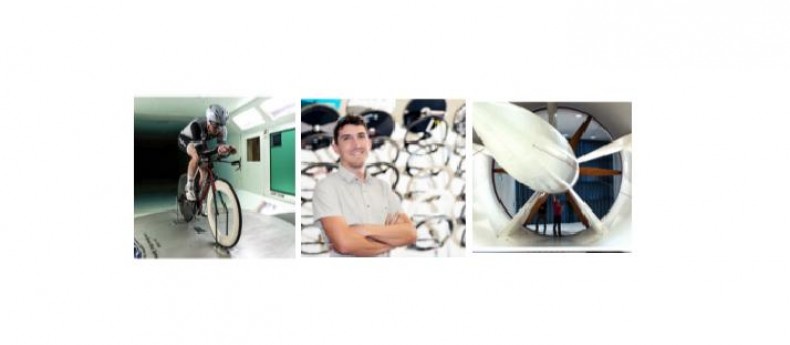INTERVISTA A DAVID MORSE, INGEGNERE ZIPP
Truth in Aerodynamics – Interview with Zipp Advanced Development Engineer David Morse
At the Zipp factory in Indianapolis we have a special windowless lab where all of our advanced design projects are developed, called the "Nest". Inside this lab Zipp advanced development engineers David Morse, Michael Hall and others take a blue sky approach to developing anything that will make a cyclist faster. Nothing is off limits here. Not only do they brainstorm, theorize and design new products in the Nest, they also prototype and test their designs to destruction there. Because, the truth is, design and theory and can only take you so far when developing a new wheel. It has to be tested and verified in the lab and the windtunnel.
We sat down with one member of this team, David Morse, to learn how Zipp verifies the aerodynamic efficiency of its wheels.
Q: We see a lot of competing claims in the marketplace relating to aerodynamics. What makes you confident that Zipp has the most aerodynamically efficient wheels?
A: When we develop a new wheel, it’s invariably our latest attempt to answer the question, “How do you make a cyclist go faster?” The framing of this question before 2008 was relatively narrow – it amounted to figuring out how to reduce longitudinal drag – the force acting against your forward progress. This has always been a primary indicator of aerodynamic performance and always will be, but the development of the Firecrest rim profile years ago started pointing us in new directions.
Michael Hall, the Advanced Development Enginnering Manager at Zipp, started looking not only at side force, but where that side force was acting on the wheel (center of pressure) and how the vortex shedding frequency (Strouhal number) affected handling characteristics. He was starting discussions no one had heard before and spawned a whole new way to think about wheel aerodynamics.
Now this new terminology is being used with almost every wheel manufacturer, and even the wind tunnels that cater to cyclists have updated their equipment, at great cost to the tunnels, to be able to measure some of the more nuanced performance metrics of bicycle components. When you open up the framing of the question, “How do you make a cyclist go faster?” longitudinal drag force becomes just one of many important factors to optimize. Rolling resistance, tire cornering dynamics, crosswind handling characteristics all play their role in the speed of a bicycle.
Q: How do you ensure that you get good data? How do you define what a good test protocol is?
A: At the start of any wind tunnel test session we put on our metaphorical lab coats and pocket protectors and we get in the zone to go to investigate and learn. Just like data collection in any field of study, sessions in the wind tunnel are tedious and sometimes boring, but it’s real science.
We mitigate as many variables as we can and track all the variables we can’t mitigate. The details are so important when testing things as subtle and transient as bicycle aerodynamics, because the differences we are trying to measure are very small and the tiniest of changes can give drastically altered results.
Q: If tiny changes in the test protocol produce a big change in the aerodynamic output, it seems like it would be easy to cherry pick numbers from the wind tunnel data that makes wheels seem especially aero. Is this right?
A: If you were hunting for favorable wind tunnel numbers, and you had a poorly controlled test protocol, there is a chance that one out of every few runs could generate some crazy good numbers to show off, but this isn’t representative of what happens most of the time and could only be recreated under controlled circumstances (like, in a wind tunnel). We’re more concerned with data that is repeatable because it is more indicative of real world performance, and we also like to have solid benchmarks to compare our evolving designs against.
Q: It sounds like there are a lot of factors that play into these measurements taken in the wind tunnel. How do you ensure consistency in your testing?
A: We keep an extensive database of every wind tunnel run. We keep this historical data for each tunnel we visit across the country, because the numbers will vary from tunnel to tunnel based on the configuration of the sensors in the tunnel, the way the test specimen is held in place, and even the way the data collection software accounts for changing atmospheric conditions like temperature and humidity. All of these variables make it very difficult to compare one set of wind tunnel tests to another, which is why these drag numbers are treated with such prudence.
Typically we try to compartmentalize sets of test data so we don’t make unfair comparisons. We try as much as possible to rely on back-to-back test runs to make true comparisons, and even then we control as many variables as possible – down to using the same tire from test to test. It’s just one example of many, but having matching tire models on two test specimens is not good enough and will introduce variation in the data.
Q: Any final points you’d like to share on the science behind Zipp’s aerodynamics?
A: The product development cycle at Zipp has been evolving and improving constantly, but one central piece of our approach to making better products that hasn’t changed over the years is our obligation to practice good science.
One of the realities of making products whose features are heavily performance based is that just about anyone can go and measure the performance of our products. If you have a few hundred dollars to blow, you could take one of our products and conduct your own wind tunnel testing against some other product. As unlikely as it is that our customers would consider this, there really isn’t a high hurdle to keep anyone from doing it. It would be foolish to make claims that can’t be corroborated or repeated, because that’s all the worth in what we’re selling. Snake oil might sell in the short term, but for decades of customer trust and brand authority you need to have done all the homework.
The best resource Zipp has available to develop new products is the “brain trust” of our entire engineering team. There is a high level of confidence that we possess the brainpower and creativity to eventually find a solution to any design or manufacturing problem. I would argue that our second most valuable resource in the product development cycle is patience. It’s a luxury that many other companies don’t think they can afford. It’s essential to fight the urge to throw a product out into the market when you’ve hit the point where you can say “good enough”. The carbon clincher is a prime example. Many of our competitors brought carbon clinchers to market years before we did– not because we couldn’t make what other people were making, but because we couldn’t see any purpose for the carbon clincher offerings on the market at the time. The big challenge with carbon clinchers was dealing with brake heat management, braking performance and overall rim strength. Hitting the numbers that we had set as our target just wasn’t possible with the resins available at the time. So we waited until we had a way to make carbon clinchers relevant and better than aluminum clinchers, or even tubulars in many respects.
Zipp has always been focused on empowering customers to learn the science and engineering behind the products so they can internalize the central ideas that make our products so good, which helps them understand how and why Zipp products perform so well. This approach is the opposite of saying, “trust us, we know what we’re talking about” and takes a lot of persistence. Historically we’ve found it to be much wider reaching, much longer lasting, and a much easier way to gain customer trust.
http://zipp.com/about/story.php?ID=655












